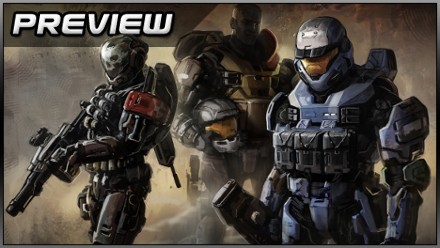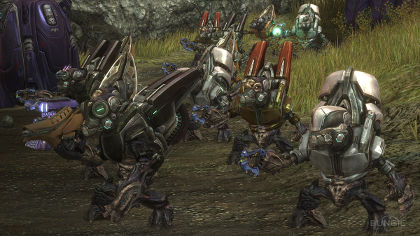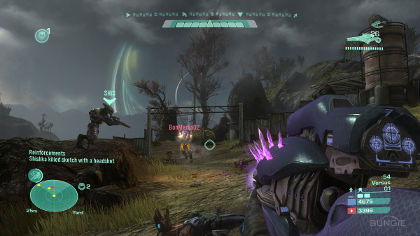
It’s impossible to convey in 1500 words just how great, how necessary the Halo franchise has become, but one way to start is by looking at something small and theoretically unimportant, something every player, however brief his or her time with a Halo game, will have encountered: the Covenant Grunt.
These shrill, tottering amphibians are Bungie’s bullet fodder, the extra-terrestrial equivalent of Wolfenstein’s goose-steppers or Modern Warfare’s sullen trrrrrists, but they have something few other generic infantry units from few other first-person shooter IPs can boast of. Personality, that is. Personality, and a degree of resourcefulness and spontaneity that makes them a credible threat long after you’ve broken the campaign’s back and are up to your power-armoured chin in Flood.
Less effusively put, the Grunts are complete and utter bastards, and this is why they’re such fun to fight. Though small, slow and fragile, their yellow-bellied tendencies and mild fanaticism are constant sources of surprise. There’s no telling when one might blow a psychological gasket, grab two handfuls of live grenade and hug the nearest pair of Spartan knees. Or flee, shrieking and flailing its arms comically, drawing the player’s fire in much the same irresistible way a dangled piece of string will lure a cat, leaving you oblivious for a crucial few seconds to the Elites sneaking round your flanks.
All qualities we’re reminded of, obviously, while playing new Halo: Reach match type Gruntpocalypse, a variant on Halo 3: ODST’s wave defence Firefight mode, that pits a team of proud upstanding Spartans against mob after mob of chattering leather-skinned Munchkins.
At first it feels like a duck-shoot, the flat roofs of the night-time Waterfront map affording plenty of places to stand and put the new single-shot Marksman rifle to use, Grunt heads popping into dandelion clocks of confetti amid the curiously macabre sound of children cheering. But before long the timed map modifiers or ‘Skulls’ lock in, tightening Covenant aims and fattening grenade belts, and the Grunts start to shun the broad unshielded expanse of the beach in favour of the cool alpine darkness to the rear of the facility.
Being the last person to know when it rains proves tactically advantageous here, as the invading forces elude our scopes by lurking on the second to topmost steps of stairwells, or trundling down shallow gullies. This becomes especially bothersome when the stumpy devils get hold of Fuel Rod Guns or the all-new, fearsome Covenant grenade launchers. If somebody can glue four heat-sensitive balls of viscous blue death to your arse in a single volley, the last thing you want that somebody to be is on the short and unobtrusive side.
Tiny yet testing, undisciplined, cowardly and thus dangerously hard to predict, the Grunts are a sort of Halo-in-miniature, a metaphor for the cavernous, multiple-jointed stage machinery that contains them. Their refusal to be uniform is Halo’s refusal to be uniform, whether you’re corkscrewing the rump of a Warthog over the rolling green hummocks of a re-made Blood Gulch map, or jetting out into the Swiss Family Robinson immensity that is ‘Forge World’, the backdrop for a tweaked, expanded, vastly more user-friendly upgrade of Halo 3′s breakthrough map editor.
A point often overlooked by those who consider Bungie’s ‘thirty seconds of fun’ philosophy reductive is that every time you play, it’s a different thirty seconds of fun. Cover points may be jogged sideways by rocket impacts; Brutes may opt to stake out a gallery rather than huddle behind a barricade in the courtyard; a Grav Lift might land askew, punting a crate across the bonnet of a Wraith. Non-linearity has always been the magic word for Halo’s spawn-free plains, roads and valleys, its scaled, responsive enemies, and the wizardry is at its most unmissable, from what we saw at a preview event last week, in Halo: Reach.
That’s apparent even in the first ten minutes of the campaign, where the presence of a six-strong, multi-specialism Spartan team has obliged the developer to push back the boundaries of play and step up the number and variety of sights and sounds. Unseen and more aggressive breeds of Jackal bring the fight to your face within a breath or two of eyes-on, crowding players who hang back from the frontline; panicked native wildlife (harmless, and bizarrely Ostrich-shaped) does its best to startle a few rounds from your clip.







 Satoru Iwata Video Interview - the late Nintendo president spoke with Kikizo in 2004 as 'Nintendo Revolution' loomed.
Satoru Iwata Video Interview - the late Nintendo president spoke with Kikizo in 2004 as 'Nintendo Revolution' loomed. Kaz Hirai Video Interview - the first of Kikizo's interviews with the man who went on to become global head of Sony.
Kaz Hirai Video Interview - the first of Kikizo's interviews with the man who went on to become global head of Sony. Ed Fries Video Interview - one of Xbox's founders discusses an epic journey from Excel to Xbox.
Ed Fries Video Interview - one of Xbox's founders discusses an epic journey from Excel to Xbox. Yu Suzuki, the Kikizo Interview - we spend time with one of gaming's most revered creators.
Yu Suzuki, the Kikizo Interview - we spend time with one of gaming's most revered creators. Tetris - The Making of an Icon: Alexey Pajitnov and Henk Rogers reveal the fascinating story behind Tetris
Tetris - The Making of an Icon: Alexey Pajitnov and Henk Rogers reveal the fascinating story behind Tetris Rare founders, Chris and Tim Stamper - their only interview? Genuinely 'rare' sit down with founders of the legendary studio.
Rare founders, Chris and Tim Stamper - their only interview? Genuinely 'rare' sit down with founders of the legendary studio. The History of First-Person Shooters - a retrospective, from Maze War to Modern Warfare
The History of First-Person Shooters - a retrospective, from Maze War to Modern Warfare
Eeehhhx L ent!
Best video game press writer.
At last, an honest commenter… How’s tricks, Loco?
How’s tricks, Loco?
This will be the best Shooter this year possibly this generation. Of course it does not have the boring color, boring AI & boring story as all of the Killzone’s have have.
This game is GOING TO ROCK!!!
Love Halo, could play the thing all day. The only bad thing about 3 is a lot of people just make extra profiles to rank down…should the exp system this time get rid of that issue, i can see myself playing it for…4, 5 yrs.